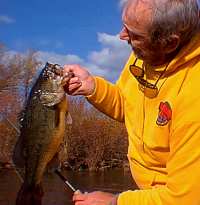|
As long as the bass season is open and the ice has come off the lakes, there's no reason to wait for April or May to catch bass in the north. If you take advantage of the fact that spring arrives a lot earlier to smaller waters, and earlier still in certain key areas in those smaller waters, you can experience some surprisingly good fishing within weeks — or even days — after the ice melts off the smallest ponds. Sometimes even while the larger ponds in the area remain iced over!
Since the early season sun rides low in southern sky, the northern shoreline receives sunlight for the longest period each day, so I'll concentrate on shallow stretches along the northern shoreline. Shallow areas have less 'heat sink' effect sucking the heat out of them. I'll look for clear water, too.  Clear water allows radiant energy to penetrate through the water and be absorbed directly by the bottom & objects that are within light penetration level. This kickstarts the food chain into gear from the bottom up. The first activity generated by this radiant energy is among the insects and invertebrates buried in or attached to bottom, rocks, logs, etc. In clear water, these shallow objects warm BEFORE the water, much in the manner that your car seats can warm from sunlight passing through the windshield, even though the air may be quite chilly. Clear water allows radiant energy to penetrate through the water and be absorbed directly by the bottom & objects that are within light penetration level. This kickstarts the food chain into gear from the bottom up. The first activity generated by this radiant energy is among the insects and invertebrates buried in or attached to bottom, rocks, logs, etc. In clear water, these shallow objects warm BEFORE the water, much in the manner that your car seats can warm from sunlight passing through the windshield, even though the air may be quite chilly.
Once the lower life forms stir, it's not long before the baitfish, then the panfish, then the bass and pickerel follow. Any active fish will find their way into these 'early life zones', so that's the best place to concentrate. Look for rocks, stumps, logs and so forth along these shorelines. If you can see it, the sunlight can reach it, and that's the key.
As far as fishing techniques go, the best of these ponds are 'walk in' fishing holes, so I travel light. The active fish I'm looking for won't likely be all that fussy anyway, so there's no need to drag along a lot of gear. I have few reservations about limiting myself to just an Arkansas shiner color 4" Fin-S Fish and a black, brown and blue combination, 1/4 ounce, 'jig and pig'. If I'm hitting a bigger body of water and using a boat, it's obviously easier to carry more gear, so I might include a spinnerbait and perhaps a Texas rigged, 4 or 5" straight tailed plastic worm in my selection. I think the straight tailed worm is important, because if I worm fish, I'm going to deadstick it a lot, and in my opinion, a curly tailed worm looks pretty stupid when it's not in motion. I want the worm to look like something that belongs there, so I go with a natural looking color, like green pumpkin, or with a nearly invisible one, like smoke.
On my first pass down a likely looking shoreline, I'll toss the unweighted Fin-S Fish, just letting it drift down near any objects or cover, and deadsticking it for 30 seconds or more before twitching it a couple times and letting it drift to bottom again. You'll almost never FEEL a hit on this lure fishing it this way. Instead, the line just starts moving off as the lure is sinking, or the little, near weightless hunk of vinyl feels 'heavy' when you twitch it. In either case, set the hook!
I'll work the bank with the Fin-S Fish, then fish my way back through the same area with the living rubber jig/trailer combination. Most of the fish I take on the jig come off the back (shoreline) side of rocks, logs, etc. in the water, so I try to cast right onto the bank and drag the jig into the water. I should point out that I don't bother with real pork frogs as jig trailers any more. Plastic trailers work every bit as well, and are a whole lot less trouble to carry when you're traveling light. My 'tackle box' on most of these early spring walk-in trips is the breast pocket of my chamois shirt.
If I still haven't gotten bit after the second pass, it might be time to head for home. Or to a different pond (or a different bay on a larger lake). If the pattern of events I'm looking for has started, there will likely be some relatively active, easy to catch fish along that northern pocket. But if I'm feeling confident that things have started and I just haven't made contact yet, I'll switch to the spinnerbait and run it deep, slow rolling it along the bottom, parallel to the bank, and just outside the cover or shallow shelf I'm fishing. Deep is a relative term. In most of my favorite early season ponds, the 'deep' water I'm fishing with the spinnerbait (and later with the 'dead-stick' 4" worm) is 4 to 6 feet.
|